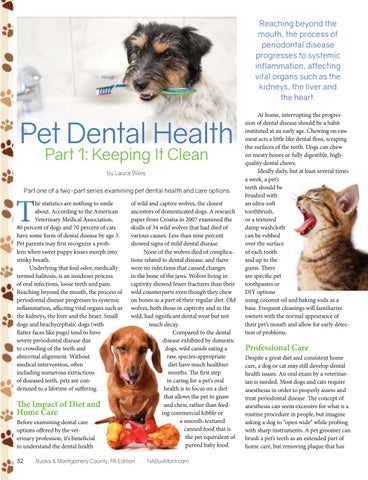Reaching beyond the mouth, the process of periodontal disease progresses to systemic inflammation, affecting vital organs such as the kidneys, the liver and the heart.
Pet Dental Health Part 1: Keeping It Clean by Laura Weis Part one of a two-part series examining pet dental health and care options
T
he statistics are nothing to smile about. According to the American Veterinary Medical Association, 80 percent of dogs and 70 percent of cats have some form of dental disease by age 3. Pet parents may first recognize a problem when sweet puppy kisses morph into stinky breath. Underlying that foul odor, medically termed halitosis, is an insidious process of oral infections, loose teeth and pain. Reaching beyond the mouth, the process of periodontal disease progresses to systemic inflammation, affecting vital organs such as the kidneys, the liver and the heart. Small dogs and brachycephalic dogs (with flatter faces like pugs) tend to have severe periodontal disease due to crowding of the teeth and abnormal alignment. Without medical intervention, often including numerous extractions of diseased teeth, pets are condemned to a lifetime of suffering.
The Impact of Diet and Home Care Before examining dental care options offered by the veterinary profession, it’s beneficial to understand the dental health 32
of wild and captive wolves, the closest ancestors of domesticated dogs. A research paper from Croatia in 2007 examined the skulls of 34 wild wolves that had died of various causes. Less than nine percent showed signs of mild dental disease. None of the wolves died of complications related to dental disease, and there were no infections that caused changes in the bone of the jaws. Wolves living in captivity showed fewer fractures than their wild counterparts even though they chew on bones as a part of their regular diet. Old wolves, both those in captivity and in the wild, had significant dental wear but not much decay. Compared to the dental disease exhibited by domestic dogs, wild canids eating a raw, species-appropriate diet have much healthier mouths. The first step in caring for a pet’s oral health is to focus on a diet that allows the pet to gnaw and chew, rather than feeding commercial kibble or a smooth-textured canned food that is the pet equivalent of pureed baby food.
Bucks & Montgomery County, PA Edition
NABuxMont.com
At home, interrupting the progression of dental disease should be a habit instituted at an early age. Chewing on raw meat acts a little like dental floss, scraping the surfaces of the teeth. Dogs can chew on meaty bones or fully digestible, highquality dental chews. Ideally daily, but at least several times a week, a pet’s teeth should be brushed with an ultra-soft toothbrush, or a textured damp washcloth can be rubbed over the surface of each tooth and up to the gums. There are specific pet toothpastes or DIY options using coconut oil and baking soda as a base. Frequent cleanings will familiarize owners with the normal appearance of their pet’s mouth and allow for early detection of problems.
Professional Care Despite a great diet and consistent home care, a dog or cat may still develop dental health issues. An oral exam by a veterinarian is needed. Most dogs and cats require anesthesia in order to properly assess and treat periodontal disease. The concept of anesthesia can seem excessive for what is a routine procedure in people, but imagine asking a dog to “open wide” while probing with sharp instruments. A pet groomer can brush a pet’s teeth as an extended part of home care, but removing plaque that has







